Public attitudes to Coronavirus – June and early July summary
This report includes some high level findings from recent polling work on public attitudes to the coronavirus pandemic in Scotland. Reports covering earlier survey work were published on 8 May and 12 June 2020.
2. Compliance
Views on guidance
Respondents were asked about their views on government guidance and advice. As shown in Figure 6, the vast majority agreed that ‘I believe the best thing to do in the current situation is to follow the government’s advice’ and this has remained stable since the beginning of June. However, a substantial minority agreed that they find it ‘easy to join in with friends and family who are not quite sticking to the rules’.
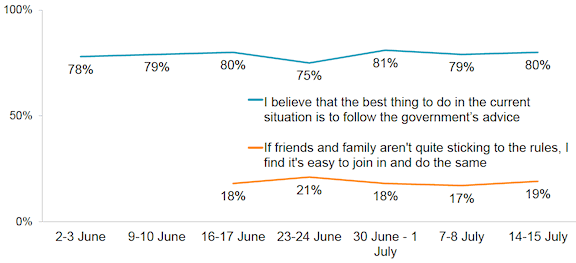
Source: YouGov weekly Scotland survey. Base (n=1003-1048)
Respondents were asked how easy or difficult they find it to stick to current guidance. As shown in Figure 7, the majority reported finding this ‘very’ or ‘fairly’ easy. The proportion who found it ‘very easy’ to stick to the guidance has decreased since the end of May.
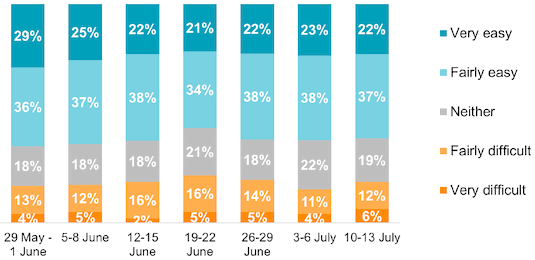
Source: Ipsos MORI, Scotland data. Base (n=500)
Levels of compliance
A list of social distancing guidelines was shown to respondents who indicated which ones they were following. Throughout April[2] and May[3] levels of claimed adherence to the majority of these guidelines was high and stable. However, since the end of May there has been a gradual decline in the proportions who were:
- avoiding meeting with family and friends inside
- avoiding gatherings with family and friends
- only leaving home for essential trips
These declines likely reflect guidance about changing lockdown restrictions, such as people being allowed to meet with family and friends inside, and meet more than two other households outdoors since 10th July. More detail can be found in Annex B.
Furthermore, at the most recent survey wave there were also declines in the proportions who were:
- avoiding travelling more than a short distance for exercise, leisure or recreation[4]
- avoiding meeting with more than two other households when outside[5]
- trying to keep 2 metres distance from people when out
- avoiding non-essential travel journeys
- avoiding contact with elderly or vulnerable people
- avoiding non-essential use of public transport
Four in ten respondents in employment were working from home, and this has remained stable over time. One in ten were not leaving home at all. This has remained stable in June but has decreased from a quarter at the start of lockdown.[6]
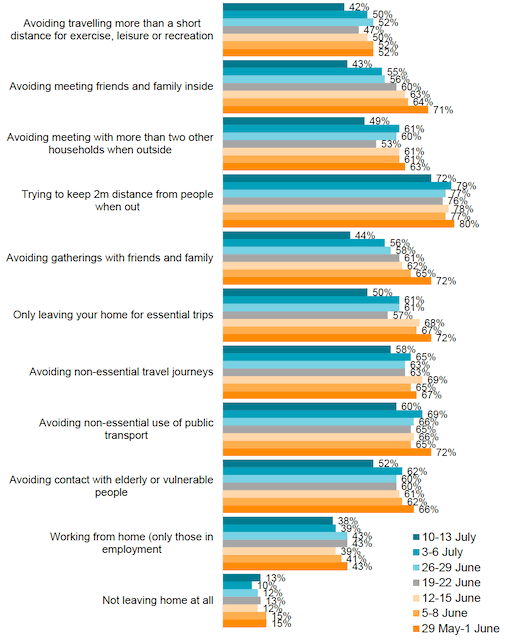
Source: Ipsos MORI, Scotland data. Base (n=500).
Personal protective actions
Further to this, respondents were asked which, if any, personal protective actions they had taken to protect themselves from Coronavirus. As shown in Figure 9, the majority of respondents reported washing their hands more often and avoiding touching hard surfaces outside the home, although these behaviours have declined slightly since the end of May. The proportion reporting wearing a face covering[7] has increased steadily since the end of April (17%, 23-26 April)[8] with a sharp increase at the latest survey wave, likely in response to the introduction of face coverings becoming mandatory in shops on 10 July.
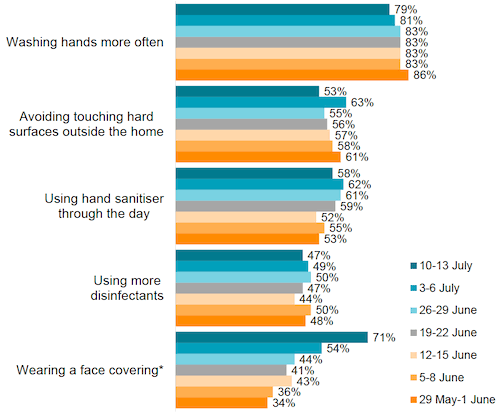
Source: Ipsos MORI, Scotland data. Base (n=500)
Respondents were also asked, from what they have seen or heard, how far they thought other people in their local area were following Scottish Government guidance. As shown in Figure 10, around half of respondents thought other people followed guidance all or most of the time and around a third thought others followed guidance some of the time. These proportions have remained fairly stable since the end of May.
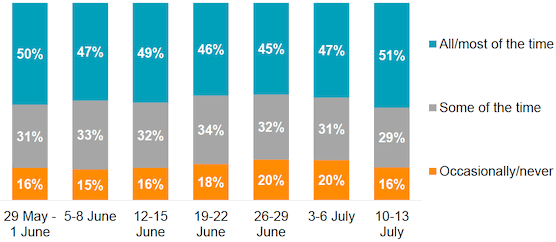
Source: Ipsos MORI, Scotland data. Base (n=500)
Testing
Respondents were asked whether they were aware of Test and Protect and whether they understood the importance of the Test and Protect programme. Figure 11 shows that the vast majority agreed that they would be happy to provide details and that they understand the importance of Test and Protect. Agreement with both statements has increased since early June.
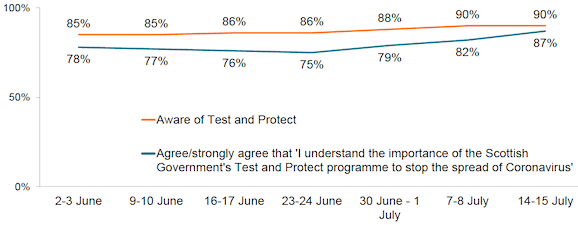
Source: YouGov weekly Scotland survey. Base (n=1003-1048).
Respondents were also asked whether they agreed or disagreed that they would be happy to provide details of people they had been in contact with if they developed Coronavirus symptoms, and whether they would be willing to isolate for 14 days if asked to do so by the NHS. Figure 12 shows high levels of anticipated compliance with both of these aspects of Test and Protect.
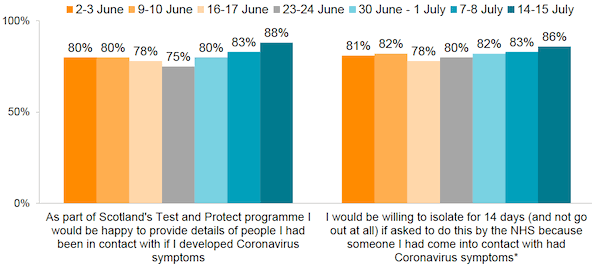
Source: YouGov weekly Scotland survey. Base (n=1003-1048).
Contact
Email: covid-19.behaviours@gov.scot
There is a problem
Thanks for your feedback